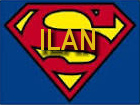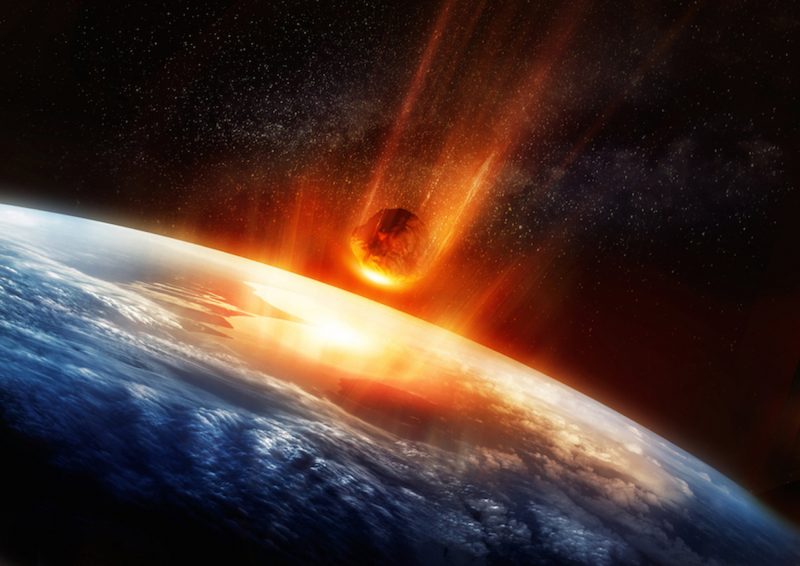Asteroid strike simulation blasts New York City
Paul Scott Anderson in EARTH | SPACE | May 13, 2019
It seems like play, but they’re serious. Every year, at the Planetary Defense Conference, asteroid experts from around the globe run days-long simulations of asteroids headed for major cities. In 2019, it was New York City’s turn.
Artist’s concept of a large asteroid hitting Earth. Image via solarseven/Shutterstock.
We’ve all seen movies about what might happen if an asteroid were to hit the Earth. While these thrilling, apocalyptic dramas are not real, asteroid experts do consider the question of what it might really be like if an asteroid used Earth for target practice. For example, what if a large asteroid were heading toward New York City specifically? If we knew far enough in advance that the asteroid were coming, could the Big Apple be saved?
That was the question posed in a new simulation, called the Planetary Defense Conference Exercise 2019, presented during the International Academy of Astronautics Planetary Defense Conference (PDC) held April 29 to May 3, 2019 in Washington, D.C. The annual conference brings together asteroid experts from NASA, the European Space Agency (ESA) and other organizations to try to understand and plan how humanity would respond if an asteroid threat were to occur. How could Earth be saved?
This article describes a simulation, an exercise, and there is no real asteroid posing a threat to Earth at this time.
Astronomers hold a new simulation every year, in which they practice using their expertise and knowledge to spare various cities from ensuing calamity. In last year’s simulation, Tokyo was successfully saved after a nuclear bomb was used to destroy the asteroid. In previous simulations, however, other places such as the French Riviera and Dhaka (largest city of Bangladesh) were not so lucky. This year’s simulation got more publicity, in part because it was highlighted on social media. Day by day on Twitter, for example, the public was able to follow along, as experts participating in the simulation were giving new parameters to consider. Rüdiger Jehn, ESA’s head of Planetary Defence, explained in a statement why experts run simulations like these. He said:
The first step in protecting our planet is knowing what’s out there. Only then, with enough warning, can we take the steps needed to prevent an asteroid strike altogether, or to minimize the damage it does on the ground.
So what about New York? Was the catastrophe averted?
Unfortunately, no.
The simulation began on Day 1 of the conference. In this scenario, a large imaginary asteroid that the conference named after itself as 2019 PDC – said to be between 330 and 1,000 feet (100 and 300 meters) in diameter – was imagined to be on a near-Earth collision course. At first, according to the simulation, the asteroid had only about a 1 percent chance of hitting the Earth, so there was not too much reason to worry. Yet. A fake press release was issued, even though the chance of impact was still very small:
College Park, Maryland, USA, April 29, 2019. The International Asteroid Warning Network has announced that a recently discovered near-Earth asteroid could pass very close to the Earth 8 years from now, on April 29, 2027, and there is a small chance – 1 in 100 – that it could impact our planet.
Day 2 of the conference was in the simulation year 2021. NASA had launched a probe to look at the asteroid more closely. At that point in the simulation, the space rock was on a collision course with Earth, and the impact site had been narrowed down to Denver, Colorado.
On Day 3 – the year 2024 in the simulation – the world’s space power nations had decided to build a fleet of six “kinetic impactors,” spacecraft designed to ram into the asteroid, slowing it down and hopefully deflecting it off course. The impactors were launched in 2024, still three years from impact, and three of them were imagined to hit the asteroid successfully. This was enough to fragment the asteroid, but there was still a problem. Although the biggest piece of the asteroid would no longer hit the Earth, a smaller fragment was imagined to be still on a collision trajectory, headed for the eastern United States.
At this point in the simulation, there wasn’t too much else that could be done. It was too late to try to nuke the incoming asteroid fragment, due to politics (as usual).
Now, analysis of the asteroid’s imaginary trajectory showed it would hit New York City. The only thing that could be done at this point was mass evacuation.
Toward the end of the simulation, the asteroid was imagined as striking Earth’s atmosphere at 43,000 mph (69,000 kmh) and exploding right over New York in a blast that was 1,000 times more powerful than the nuclear bomb dropped on Hiroshima, Japan. New York City, the largest city in North America, was no more.
All of this is, of course, just an exercise. But simulations like these help experts figure just what actions might be taken, if an asteroid were discovered to be on a collision course with Earth. At this point in Earth’s history, there are no large asteroids known to be headed our way. And the odds of a large asteroid hitting Earth at any given time are statistically exceedingly low. However, as astronomers have come to recognize more profoundly in recent decades, asteroid strikes do happen. They’ve happened before and could happen again.
The dinosaurs unfortunately experienced this firsthand, 65 million years ago. And if it happened before, it can happen again, at some point. We don’t know exactly when, though, so it is prudent to be ready at all times, even if the chance of the unthinkable happening is small.
About 20,000 near-Earth asteroids have been discovered so far, with another 150 or so new ones found every month, according to the Center for Near Earth Object Studies (CNEOS).
NASA and the Federal Emergency Management Agency (FEMA) also released an 18-page document in June 2018 explaining what steps the agencies would take over the next 10 years to prevent actual potential asteroid strikes and to prepare the country for the worst if one did hit us. That plan is two-fold, increasing ground-based surveillance of near-Earth asteroids and having a protocol in place for mass evacuations. This would require other nations to work with the U.S., a worthy goal since we don’t know just when or where an asteroid will hit, the next time one does.
In all probability, another asteroid will strike Earth, eventually, even if it’s tens of thousands of years from now. Let’s hope a future human civilization will fare better than the dinosaurs did 65 million years ago.
Bottom line: In 2019’s Planetary Defense Conference simulation, New York City was obliterated by an asteroid fragment that hit Earth in 2027. Although not based on reality, simulations such as these are designed to help NASA, ESA, FEMA and other agencies prepare for a time if – or when – just such a catastrophe really does happen again.
______________________________________
The very big ones are usually detected well ahead of their Earth approach. However, plenty of the smaller ones that could do a great deal of damage aren't discovered until days or even hours before their near-Earth approach. At that point, it would probably be too late to do anything of a substantial nature. - ilan
 |
 |
|
|||||||||||
 |
 |
||||||||||||
|
|
|
|
|
|
|
||||||||
 |
|
|
|
|
|
 |
|||||||
|
|
|
|
|||||||||||
|
|
|||||||||||||
|
|
|
|
|
|
|
|
|
|
|
|
|
|
|
Results 1 to 3 of 3
-
05-13-2019, 12:16 PM #1
Asteroid strike simulation blasts New York City
Last edited by ilan; 05-14-2019 at 12:57 AM.
Beginner's Guide for Rocket, NFPS and IKS66...
http://iptvtalk.net/showthread.php?2...-you-should-do
Kodi Options for Rocket, NFPS and IKS66...
http://iptvtalk.net/forumdisplay.php?71-Kodi
Check the Announcement Section...
http://iptvtalk.net/forumdisplay.php...-Announcements
-
05-13-2019, 03:39 PM #2Pinball Wizard












- Join Date
- Nov 2014
- Location
- yes
- Posts
- 9,529
- Rep Power
- 293
i could not imagine the devastation of a meteorite strike but history has a way of repeating itself. That being said i have been watching the documentaries on the devastation Chernobyl cause and that was just one reactor out of four. It was horrific and downright scary!! Nice post Ilan!
-
05-14-2019, 01:01 AM #3
Both are nasty ways to destroy this little planet we call home.
Beginner's Guide for Rocket, NFPS and IKS66...
http://iptvtalk.net/showthread.php?2...-you-should-do
Kodi Options for Rocket, NFPS and IKS66...
http://iptvtalk.net/forumdisplay.php?71-Kodi
Check the Announcement Section...
http://iptvtalk.net/forumdisplay.php...-Announcements
Similar Threads
-
Doctors On Strike.......
By bwcbob in forum Jokes/Humor Forum in honor of bwcbobReplies: 0Last Post: 08-03-2019, 12:07 PM -
Detailed Simulation of a Black Hole - video
By ilan in forum The Universe in ReviewReplies: 0Last Post: 06-06-2019, 11:37 AM -
Asteroid flyby ... asteroid originally designated ZLAF9B2 – now called 2018 LA
By ilan in forum The Universe Closer to HomeReplies: 0Last Post: 06-04-2018, 12:06 PM -
A businessman walked into a New York City bank
By 4wheelin in forum Jokes/Humor Forum in honor of bwcbobReplies: 1Last Post: 12-30-2015, 05:29 AM -
Verizon goes on strike!
By Bkman2020 in forum Chit Chat LoungeReplies: 0Last Post: 07-27-2015, 05:03 PM





 Reply With Quote
Reply With Quote